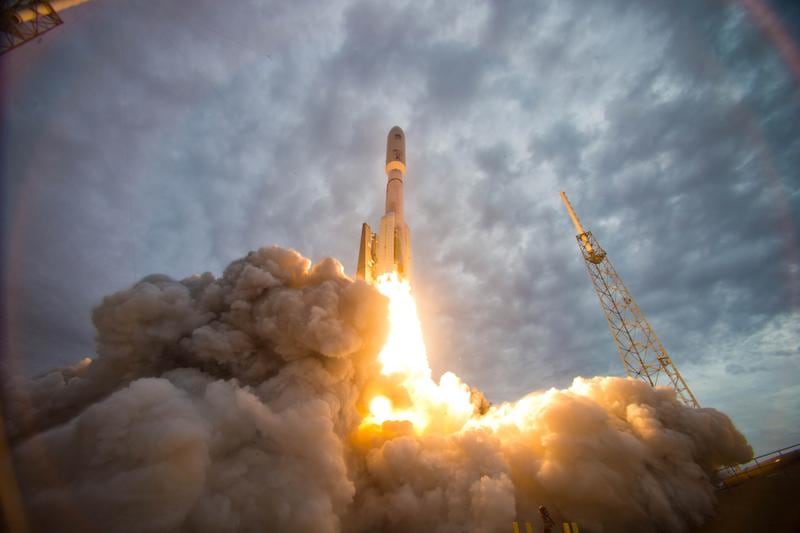WASHINGTON — U.S. President Donald Trump wants a new military “Space Force,” but Congress isn’t ready for blast off.
The Senate and House did come together Monday on a $716 billion defense authorization report that could set the stage for a sixth military service dedicated to space. It would create a sub-unified command for space under Nebraska-based U.S. Strategic Command, whose main mission is to oversee the military’s nuclear arsenal.
“You could view this as some of the preparatory work. They’re trying to get the Air Force in better shape to spin off its space forces,” said Todd Harrison, director of the aerospace security project at the Center for Strategic and International Studies.
“What they’re not doing is trying to integrate space forces across the military. The only way to really do that would be to actually set up a separate department,” Harrison said, adding that the Air Force's space forces are outnumbered by the combined space forces of the other services.
A House-proposed requirement to establish a new numbered Air Force dedicated to space war fighting was dropped, likely to compromise with members of the the Senate Armed Services Committee, where the idea of a separate service was largely met with skepticism, if not opposition.
Stoking fears about the militarization of space, the Pentagon would also have to develop a comprehensive space war-fighting strategy (by April 2019) aimed at attributing attacks in space, resolving conflicts, and deterring, defending against and defeating aggressive behavior in space.
America’s adversaries, and the public, might one day be able to learn more about the military’s secretive activities in space; the Pentagon would have to examine the feasibility of a declassification strategy to ensure deterrence.
The conference report for the sweeping 2019 National Defense Authorization Act is expected to come to a vote in the House this week and the Senate next week. The annual must-pass bill covers military hardware, personnel and a wide swath of hot-button national security issues.
To be clear, when Trump last month ordered the Pentagon to begin establishing a new “Space Force,” a process that could add a sixth military service to the Defense Department, Congress was not expected to snap to immediately.
Congress is waiting for one Pentagon report on the topic, due next month, that it mandated in the last NDAA and another from the Center for Naval Analyses by year’s end on a possible road map to establish a separate space service. Congress might then incorporate its recommendations into future NDAAs.
RELATED

Proponents of a military service for space argue America’s military has become evermore dependent on satellites for communication, intelligence and navigation, and that it must move quickly to counter Russia and China as they work to exploit that vulnerability. Opponents have challenged the idea as creating more bureaucracy, though they may also wish to protect established organizations likely to lose money and power to a newcomer.
It’s unclear whether Trump can secure the necessary congressional support for the eventual plan, what its timeline would be, or whether it would fall under the Department of the Air Force or warrant its own department and budget.
But Trump’s support energized the effort after the White House, Defense Secretary Jim Mattis and some lawmakers panned the idea last year. Air Force Chief of Staff Gen. David Goldfein, notably, has since switched positions to embrace it.
On the other hand, if the House or Senate flip to Democratic control in midterm elections this November, the idea could suffer by association with the president. “Its going to be difficult for Democrats to support it,” Harrison said.
Under the proposed 2019 NDAA, the leader of the sub-unified command for space could, for three years, be a dual-hat position for the commander of Air Force Space Command. That flag officer would be responsible for space strategy, doctrine, tactics and budget proposals — as well as capability requirements, training and personnel.
With the creation of the three-star vice commander of Air Force Space Command earlier this year, the service added the first uniformed leader based in the Pentagon purely dedicated to promoting military space operations.
The Defense Department, under the NDAA, would be required to develop a plan by year’s end to establish a separate, alternative process for space-related acquisitions, likely meant to cure the current sluggish, bureaucratic acquisition process.
The recently renamed Space Rapid Capabilities Office, which answers to the head of Air Force Space Command, would have streamlined acquisition authorities outside of the standard Joint Capabilities Integration and Development System. It would in part develop classified capabilities as well as “low-cost, rapid reaction payloads, buses, launch, and launch control capabilities in order to fulfill joint military operational requirements for on-demand space support and reconstitution.”
The report emphasizes development of small, medium and large buses; protected satellite communications; space-based environmental monitoring; and next-generation overhead persistent infrared systems, the follow-on for the current Space-Based Infrared System.
The secretary of the Air Force would also develop a plan to improve the quality of the service’s space cadre, likely an attempt to remedy concerns that space is a dead-end career path.
Valerie Insinna contributed to this report.
Joe Gould was the senior Pentagon reporter for Defense News, covering the intersection of national security policy, politics and the defense industry. He had previously served as Congress reporter.



